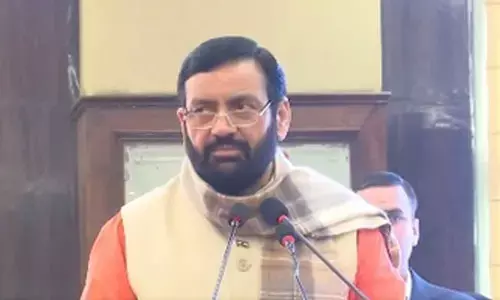FairPoint: Time for opposition-minus Congress to define its path
Share :

Is it the right time for the opposition-minus Congress to assert its identity? The question may seem overstated, but the reality is that the rest of the opposition needs to emerge from Congress' shadow.
New Delhi: Is it the right time for the opposition-minus Congress to assert its identity? The question may seem overstated, but the reality is that the rest of the opposition needs to emerge from Congress' shadow.
For most of India's post-independence history, the Congress has governed the country. Even during its out-of-power periods, it has often dominated the opposition, except briefly in the Janata Party era.
The opposition at the national level has been mostly revolving around the Congress. Often the grand old party’s stance on issues is taken as the position of the rest of the opposition parties. The Congress’ agenda for the past 10 years has been mostly about attacking the Prime Minister personally and politically, allegedly linking him and the BJP to business tycoons repeatedly and every day. The rest of the opposition is also seen as a follower of the Congress game plan. The voice of the rest of the opposition often gets overwhelmed by the Congress’ din.
This is where the rest of the opposition has to draw its line. It must assert its own identity.
The electoral performance is what matters ultimately in politics. The grand old party has been badly lagging while the rest of the opposition has been faring better in most of the elections, whether central, state or even in local municipalities. In comparison, Congress has been losing its electoral significance as a political party, especially in regions where it had a significant presence.
Take the case of the recently held Maharashtra Assembly election. An analysis of the election results shows that the INDIA Bloc suffered defeat more because of Congress than its smaller allies -- Uddhav Thackeray’s SS(UBT) and Sharad Pawar's NCP(SP).
The poll battle which should have been Mahayuti vs MVA emerged as a contest between BJP and Congress. The two parties took on each other head-on in at least 75 seats. Of these, the BJP was victorious in 65 seats. The Congress didn’t even come in second place in at least six constituencies. Congress allies SS(UBT) and NCP(SP) managed a respectable vote share in seats with a direct fight with the BJP. But, as per the Election Commission of India (ECI) records, Congress trailed BJP’s vote share by a staggering 14 per cent.
Also, the BJP managed a whopping strike rate of about 89 per cent, winning 132 out of 149 seats that it contested in the 288-member Assembly while for Congress, it stood at 25 per cent. The strike rate of BJP’s allies including SS and NCP hovered around 70 per cent.
Both Shiv Sena and the NCP improved their tally in the 2024 Maharashtra Assembly elections compared to 2019.
In 2019, the ‘undivided’ Sena bagged 56 seats while the factions claimed victory in 77 seats (SS - 57 and SS(UBT) - 20) and NCP got 54 in 2019, which rose to 51 (NCP(SP) and NCP put together) in 2024. It is the Congress party which plummeted from 44 in 2019 to 16 seats in 2024 polls.
Maharashtra should serve as an important case study for the rest of the opposition. The Assembly elections of Haryana and before that the polls in Madhya Pradesh, Chhattisgarh and Rajasthan should also be dissected. The analysis of the 2024 Lok Sabha elections should be taken as a lesson for the rest of the opposition.
In the 2024 Lok Sabha elections, Congress secured 99 seats, marking an improvement over its previous two performances. The gains were largely in regions where it depended on stronger regional allies to counter the BJP’s dominance.
Its wins were not mostly because of its performance but mainly due to the influences of its regional partners. For instance, in the Lok Sabha elections in Uttar Pradesh, it was chiefly Akhilesh Yadav’s Samajwadi party that did the best in the INDIA bloc and helped the Congress to gain also. The Samajwadi party raised its tally to 37 seats from five and its vote share jumped from 18.11 per cent to 33.59 per cent. Congress increased its vote share by over three per cent to 9.46 per cent with six seats against one earlier.
While SP helped Congress in Uttar Pradesh, the scene was politically pathetic in the Madhya Pradesh Assembly elections where the grand old party refused to accommodate Akhilesh Yadav’s party.
In the bypolls also, Congress fared poorly in comparison to its INDIA Bloc allies. The Trinamool Congress and the Aam Aadmi Party did much better. The only consolation for the Congress party was winning all three seats in Karnataka and retaining one in Madhya Pradesh. However, its performance in Rajasthan, Assam, Punjab and Gujarat was poor.
In the Jharkhand Assembly polls, which the INDIA Bloc has been celebrating, the truth is that Hemant Soren-led JMM’s strong performance secured the victory. It certainly was not Congress’ win.
Even in the South, the DMK has been going strong and has elbowed out all, including Congress though it is its INDIA Bloc ally.
The rest of the opposition is repeatedly getting the signals from the people. All it needs is to make strong decisions and chart its course. Minus Congress the rest of the opposition can exist. But, it requires a common agenda and unity – the two most challenging factors in the whole opposition, whether with Congress or minus Congress.









